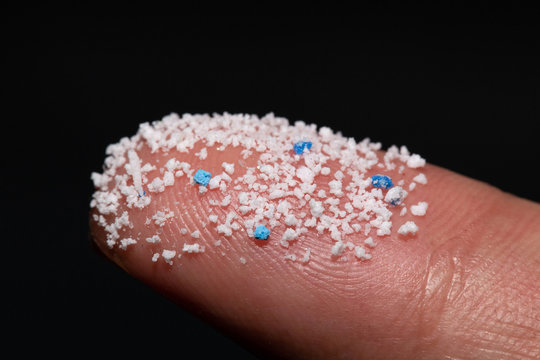Babies may be exposed to microplastics from putting toys in their mouths or from plastic baby bottles, sippy cups, and pacifiers that might shed pieces of PET.
Microplastics, or tiny particles of synthetic material smaller than five millimeters, can be virtually found everywhere. When plastic bottles or plastic bags break down, they degrade into tiny pieces that can seep into the smallest nooks out in nature. When washing synthetic fibers, parts break off and flow back into our water sources. Microplastics can even be found in the world’s most remote areas like the Arctic and the deepest parts of the oceans, reports Wired’s Matt Simon.
Now, scientists have found the synthetic materials in infant poop, according to a small pilot study published in Environmental Science & Technology Letters. Based on body weight, microplastics in baby poop were ten times higher than those found in adult feces, reports Justine Calma for the Verge. Researchers collected fecal samples from ten adults and six infants from New York state, reports Ed Cara for Gizmodo. The team also sampled three newborns’ very first poop, per the Verge. Despite the study’s small sample size, the results show more research is needed to understand how microplastics affect people of all ages.
“Our data provide baseline evidence for exposure doses in infants and adults and support the need for further studies with a larger sample size to corroborate and extend our findings,” the study explains.
Within the fecal matter, researchers were looking for traces of two commonly found plastics: polyethylene terephthalate (PET) and polycarbonate. To ensure that the plastic found in infant poop was not from their diaper, researchers ruled out traces of polypropylene, a polymer commonly found in diapers, per Wired. Within all collected samples of poop, researchers found at least one type of plastic. Traces of plastic were also found in the newborn’s first bowel movement, suggesting that the plastic was already in their systems.
“Babies are exposed to high levels of plastics, something needs to be done,” says study author Kurunthachalam Kannan, a professor of environmental medicine and pediatrics at the New York University School of Medicine. “Early life stages are very vulnerable.”
The findings build on previous research published this year in Pharmaceutics that has found microplastics in human placentas, Wired reports. A 2019 study published in Chemosphere also found that pieces of plastic could break down small enough to pass through cell membranes and make their way into the body’s circulatory system, the Verge reports. Microplastics in blood could lead to cell death and inflammation. Plastics also contain hormone-disrupting chemicals that could affect reproductive, metabolic, and neurological health. The new study’s finding of microplastics in infant feces is alarming because babies are more prone to negative health effects during development.
Babies may be exposed to microplastics from putting toys in their mouths or from plastic baby bottles, sippy cups, and pacifiers that might shed pieces of PET, the Verge reports. Babies that are in their crawling stage may also inhale microfibers from polyester carpeting.
PET is derived from natural gas and crude oil. PET is also the chemical name for polyester, and its fibers are added to fabrics like rayon, wool, and cotton to make them resistant to wrinkling. The stiff, lightweight synthetic fiber is molded into plastic containers used to package food, beverages and other products, including mouthwash, peanut butter, liquid hand soap, cooking oils, disposable soft drink bottles and many other products. The synthetic fiber is frequently used because it can be heated to a molten liquid and then easily molded into any shape. While PET is the most recycled type of plastic, only 20 percent of the material actually gets disposed of properly.
“This is a very interesting paper with some very worrying numbers,” Deonie Allen, a microplastics expert at the University of Strathclyde in Glasgow, who was not involved in the study, told Wired. “We need to look at everything a child is exposed to, not just their bottles and toys.”
https://www.smithsonianmag.com/smart-news/study-shows-infant-poop-is-riddled-with-microplastics-180978770/

